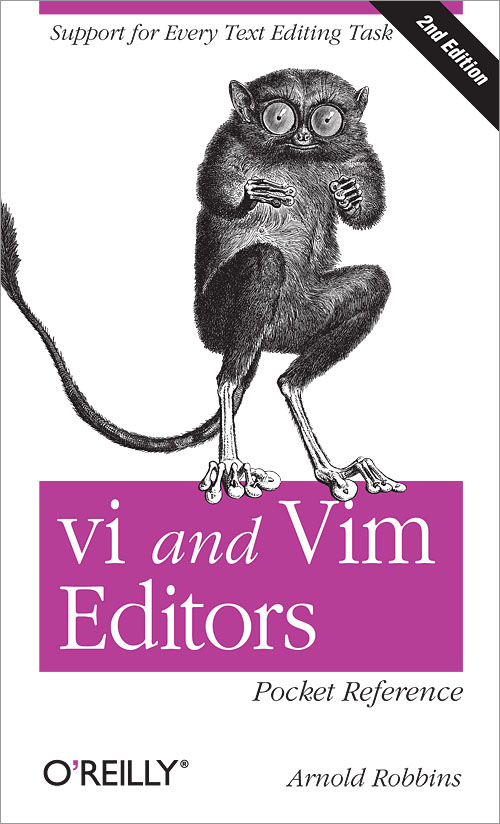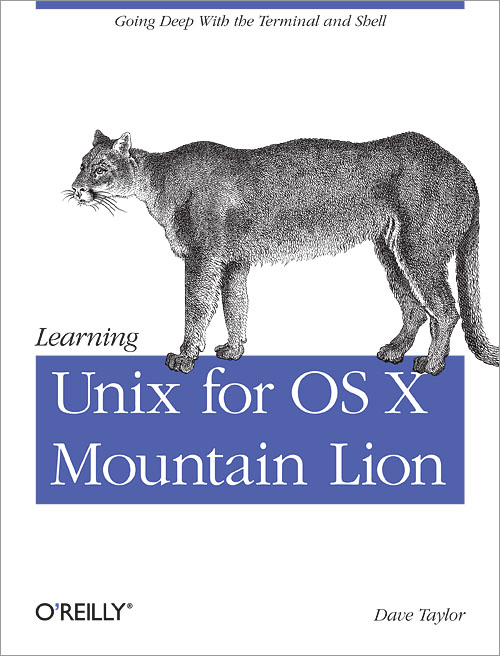Category Archives: Books
Learning Unix for OS X Mountain Lion
Chapter 1 : Why Use Unix?
-The Power of Unix
-Folders or Directories?
-Thousands of Free Applications
-Commands Included with Unix
-A Simple Guided (Unix) Tour
Chapter 2 : Using the Terminal
-Launching the Terminal
-Customizing Your Terminal Session
-Working with the Terminal
-Customizing the Shell Environment
-Advanced Shell Customization
-The Unresponsive Terminal
Chapter 3 : Exploring the Filesystem
-The OS X Filesystem
-Listing Files and Directories
-Calculating File Size and Disk Space
-Protecting and Sharing Files
-Changing Your Password
-Superuser Privileges with sudo
-Exploring External Volumes
Chapter 4 : File Management
-File and Directory Names
-File and Directory Wildcards
-Looking Inside Files
-Creating and Editing Files
-Managing Files
Chapter 5 : Finding Files and Information
-The Oddly Named grep Command
-Finding Files with locate
-Using find to Explore Your Filesystem
-Shining a Light on Spotlight
Chapter 6 : Redirecting I/O
-Standard Input and Standard Output
-Pipes and Filters
-Printing
Chapter 7 : Multitasking
-Running a Command in the Background
-Checking on a Process
-Canceling a Process
-Launching GUI Applications
Chapter 8 : Taking Unix Online
-Remote Logins
-Transferring Files
Chapter 9 : Of Windows and X11
-X11
-GIMP, the X11 Graphics Editor
Chapter 10 : Where to Go from Here
-Documentation
-Customizing Your Unix Experience
Unix Power Tools, 3rd Edition
Part I: Basic Unix Environment
Chapter 1: Introduction
Chapter 2: Getting Help
Part II: Customizing Your Environment
Chapter 3: Setting Up Your Unix Shell
Chapter 4: Interacting with Your Environment
Chapter 5: Getting the Most out of Terminals, xterm, and X Windows
Chapter 6: Your X Environment
Part III: Working with Files and Directories
Chapter 7: Directory Organization
Chapter 8: Directories and Files
Chapter 9: Finding Files with find
Chapter 10: Linking, Renaming, and Copying Files
Chapter 11: Comparing Files
Chapter 12: Showing What’s in a File
Chapter 13: Searching Through Files
Chapter 14: Removing Files
Chapter 15: Optimizing Disk Space
Part IV: Basic Editing
Chapter 16: Spell Checking, Word Counting, and Textual Analysis
Chapter 17: vi Tips and Tricks
Chapter 18: Creating Custom Commands in vi
Chapter 19: GNU Emacs
Chapter 20: Batch Editing
Chapter 21: You Can’t Quite Call This Editing
Chapter 22: Sorting
Part V: Processes and the Kernel
Chapter 23: Job Control
Chapter 24: Starting, Stopping, and Killing Processes
Chapter 25: Delayed Execution
Chapter 26: System Performance and Profiling
Part VI: Scripting
Chapter 27: Shell Interpretation
Chapter 28: Saving Time on the Command Line
Chapter 29: Custom Commands
Chapter 30: The Use of History
Chapter 31: Moving Around in a Hurry
Chapter 32: Regular Expressions (Pattern Matching)
Chapter 33: Wildcards
Chapter 34: The sed Stream Editor
Chapter 35: Shell Programming for the Uninitiated
Chapter 36: Shell Programming for the Initiated
Chapter 37: Shell Script Debugging and Gotchas
Part VII: Extending and Managing Your Environment
Chapter 38: Backing Up Files
Chapter 39: Creating and Reading Archives
Chapter 40: Software Installation
Chapter 41: Perl
Chapter 42: Python
Part VIII: Communication and Connectivity
Chapter 43: Redirecting Input and Output
Chapter 44: Devices
Chapter 45: Printing
Chapter 46: Connectivity
Chapter 47: Connecting to MS Windows
Part IX: Security
Chapter 48: Security Basics
Chapter 49: Root, Group, and User Management
Chapter 50: File Security, Ownership, and Sharing
Chapter 51: SSH

